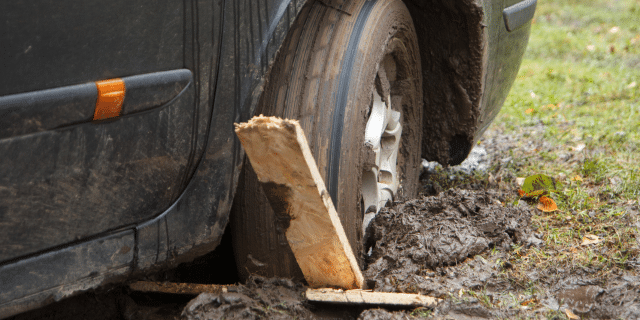
by California Casualty | Auto Insurance Info, Safety |
There’s nothing quite like prom and graduation season—the photos, the dresses and tuxes, the flowers, the celebrations. But while your teen may be focused on finding the perfect outfit or planning the after party, you’re likely thinking about something else entirely: their safety on the road.
Here are some tips to help your teen navigate prom, graduation, and all the celebrations in between—safely.
1. Make “leaving early” a habit.
Encourage your teen to leave at least 10 minutes earlier than needed—more if weather conditions are poor. This reduces the urge to speed and gives them time to react calmly to traffic or detours. If they’re heading to the same event as many others, they might also encounter fewer cars and pedestrians if they beat the rush.
2. Limit passengers.
It’s fun to pile into a car with friends, but the more people you have, the more distractions the driver encounters. Set limits on how many friends can ride with your teen and remind them that safety comes before socializing.
3. Always buckle up.
Seat belts are simple but lifesaving. Make sure your teen—and everyone in their car—buckles up before the engine starts. Reinforce the message that seat belts are non-negotiable, even for short trips.
4. Phones down, eyes up.
Phones are one of the biggest distractions for drivers, especially teens. Talk with your teen about putting their phone away while driving. There are apps that can silence notifications, send automatic replies, and even block texts while the car is in motion. Sharing their location with you is also a smart move in case you need to reach them in an emergency.
5. Minimize all distractions.
Texting isn’t the only distraction. Eating, drinking, adjusting the music, or checking makeup can all take attention off the road. Remind your teen to stay focused and wait until they’re parked to multitask.
6. Don’t drive while drowsy.
With finals, late-night celebrations, and packed schedules, your teen may not be getting enough sleep. Driving tired is just as dangerous as driving under the influence. If they feel themselves nodding off, they should pull over in a safe place and rest before continuing.
7. No drinking and driving—ever.
This one may seem obvious, but it bears repeating. Teens should never get behind the wheel after drinking or using any substance. Have an open conversation about peer pressure and agree on a “safe word” they can use if they need you to pick them up—no questions asked.
8. Keep an emergency kit in the car.
Whether it’s a flat tire, dead battery, or a minor fender bender, your teen should know what to do in case of a car emergency. Pack a basic kit with a flashlight, jumper cables, water, a first-aid kit, and emergency contact numbers. Make sure they know how to use everything in it. Teach your teen basic vehicle care and warning signs.
9. Be accident-ready, just in case.
Teens are often accident-prone because of their inexperience behind the wheel. Make sure your teen knows what to do if they’re ever in a crash. Go over the basics together: stay calm, check for injuries, move to safety, call 911, and exchange information with the other driver. Keeping an emergency kit in the car and insurance details in the glove box can also help them feel more prepared and confident.
10. Set a curfew.
More than 40% of fatal crashes involving young drivers happen between 9 p.m. and 6 a.m. It’s not just the challenge of driving in the dark—late-night trips are often social outings where distractions and peer pressure can run high. Even rule-following teens can be tempted to take risks. Setting an earlier curfew than your state requires can help keep your teen safer. Bonus: Offer to drive them and pick them up for late night outings.
11. Control the keys.
When teens have to ask for the car, it naturally opens the door for conversation. It’s a built-in pause that gives parents a moment to check in—about where they’re headed, who they’ll be with, and when they plan to return. It’s also a subtle reminder that driving is a privilege, not a right, and that responsibility comes with it. Keeping the keys in your hands helps reinforce expectations and encourages accountability.
12. Monitor risky behavior.
Consider a monitoring device or app that can track risky behaviors such as speeding, abrupt acceleration and sudden braking. You can also keep tabs on your teen’s location with GPS tracking. Some systems have a silent alarm so your teen can signal SOS if they feel unsafe.
Finally, this is a good time to review your insurance. Is your teen properly covered? Have you discussed all the ways you can save with a teen driver? Ensuring your policy is up to date can give both of you peace of mind during this high-risk season.
Prom and graduation are once-in-a-lifetime milestones, and you want your teen to enjoy them to the fullest—safely. Start the conversation early, model safe driving behavior yourself, and let them know you’re always just a phone call away. Your guidance and trust go a long way in helping them make smart decisions behind the wheel.
This article is furnished by California Casualty, providing auto and home insurance to educators, law enforcement officers, firefighters, and nurses. Get a quote at 1.866.704.8614 or www.calcas.com.

by California Casualty | Helpful Tips, Homeowners Insurance Info |
If clutter has crept into every corner of your home, spring is your golden opportunity to clear it out and start fresh. This season isn’t just about cleaning—it’s about creating space for what truly matters. Whether you’re dreaming of tidy shelves, organized closets, or just a little more breathing room, these smart decluttering tips will help you reduce the mess and refresh your mindset.
Where to Start
The clutter didn’t happen overnight—and it won’t disappear overnight either. That’s okay! Decluttering is a process, not a race. Here’s how to get started:
- Pick one clutter hotspot—a shelf, drawer, or closet. Starting small builds momentum.
- Set a timer for 15, 30, or 60 minutes—whatever works for you. This helps keep you focused and prevents burnout.
- Take before-and-after photos. You’ll be amazed at the progress, and it’ll keep you motivated.
- Enlist help. A friend or family member can make the process more fun—and help you decide what stays and what goes.
- Create a home inventory. As you declutter, jot down big-ticket items or anything valuable. It can come in handy for insurance purposes.
Want a broader strategy? Check out our blog on Easy Ways to Declutter Your Home. For now, here are room-by-room tips to guide your spring-cleaning mission.
General Decluttering Tips
Use the Four-Box Method: Label boxes or bins as Trash, Give Away, Keep, and Relocate. Sort items accordingly.
- Clear surfaces: Flat spaces attract clutter. Find permanent spots for items or consider letting them go.
- Ditch the broken stuff: If it’s beyond repair (like a broken umbrella or snapped sunglasses), it’s time to toss it.
- Let go of guilt items: If you’ve been holding on to something out of guilt—not love—donate it.
Entryway
Clear the catch-all zone: This area often becomes a drop zone. Use bins, hooks, or a small table to keep it tidy.
- Sort the mail daily:
- Open and sort as soon as you walk in.
- Create a system for bills, items to respond to, and recycling.
- Avoid the dreaded mail mountain!
Kitchen
Spices: Toss any older than a year. No scent = no flavor.
- Refrigerator and freezer: Discard expired or mystery items.
- Cookbooks: Keep only your go-to favorites. Donate the rest.
- Takeout menus and condiments: Menus are online; sauces don’t last forever—ditch the extras.
- Appliance manuals: Recycle any available manuals online. Organize your appliance warranties.
- Specialty appliances: If you haven’t used it in the past year, it may be time to let it go.
- Under the sink:
- Organize essentials within reach.
- Relocate overflow items to a closet or garage shelf.
- Drawer clutter: Use dividers for utensils, tools, and gadgets.
- Mugs: Keep your favorites. Donate duplicates.
Bathroom
Clear containers: Transparent acrylic bins let you see what you have.
- Sort by category: Hair, dental, skincare, first aid—group like with like.
- Makeup:
- Mascara: Replace every 3 months
- Foundation/Concealer: Replace annually
- Lipstick, eyeshadow, blush: Replace every 2 years
- Donate unused items in good condition.
- Medications:
- Dispose of expired or unidentifiable meds safely. Local police stations often have drop-off bins.
- Eyewear: Donate old prescription glasses and frames.
Bedroom
Clothing
- Organize by type: Lay out all jeans, skirts, or shirts. Keep what you love, donate the rest.
- One-year rule: Haven’t worn it in a year? It’s probably time to part ways.
- Donation bin: Keep a labeled bin in your closet so it’s easy to add items as you go.
Shoes and Socks
- Toss worn-out or single shoes.
- Donate pairs you haven’t worn in a year.
- Bye-bye, lonely socks! Toss any that don’t have a match.
Playroom
- Toys:
- Donate those your child has outgrown.
- Toss games with missing or broken parts.
- Crafts:
- Contain supplies to a shelf or bin.
- Use small containers or drawer organizers for easy access.
- Prevent duplicate purchases by taking inventory.
- Artwork:
- Display your child’s favorites.
- Repurpose others as wrapping paper or recycle.
Office
Receipts:
-
- Scan important ones and toss the rest.
- Remember: thermal paper isn’t recyclable.
- Cords and chargers:
- Sort, label, and get rid of the mystery wires.
- Make sure your extension cords are in good working order.
- Files and papers:
- Shred what you no longer need.
- Store important documents in labeled folders.
Books: Keep the ones that hold sentimental value or that you plan to reread. Donate the rest.
- Remote controls: Recycle the ones you no longer use.
- Media: Donate or sell CDs, DVDs, and other outdated formats.
Old paint: If it’s dried out or more than a few years old, it’s probably time to toss it (check local disposal guidelines).
- Tools:
- Hang them on utility racks or pegboards.
- Organize by type and label for easy access.
- Boxes: Go through those mystery boxes—keep what matters, recycle the rest.
Keep Clutter from Coming Back
One-in, one-out rule: For every new item you bring in, donate or discard one.
- Daily donations: Give away one item per day—365 things gone in a year!
- Avoid unnecessary freebies: Don’t bring home samples or giveaways unless you’ll use them.
- Think before bulk buying: Only stock up on what you actually use regularly.
- Reusable bags: Store them in your car so you don’t keep collecting new ones.
- Evening reset: Take five minutes before bed to clear surfaces and put things back where they belong.
Spring is the perfect time to not only declutter but to reevaluate your protection at home. A clean, organized home paired with the right insurance coverage provides the ultimate peace of mind.
This article is furnished by California Casualty, providing auto and home insurance to educators, law enforcement officers, firefighters, and nurses. Get a quote at 1.866.704.8614 or www.calcas.com.

by California Casualty | Pets, Travel |
Whether your pet is a seasoned jetsetter or a first-time flyer, navigating air travel with a four-legged friend takes planning, patience, and know-how. From booking the right seat to ensuring a smooth security check, here’s how to make flying with your pet a paws-itively stress-free adventure!
Cabin or Cargo? Choosing the Best Travel Option
Your pet’s size will determine whether they can fly in the cabin with you or if they must go in cargo. Cargo is not for every pet, and if you must consider it, make sure to check with your vet that it is safe for your pet’s breed, age and health.
Carry-On Pets:
- Pets in the plane’s cabin are limited to cats and small dogs meeting size requirements.
- Your pet must remain in a carrier under the seat in front of you for the flight.
- Some airlines allow you to purchase an extra seat for your pet carrier. You still will need to keep your pet in the carrier, and you also will need to place the carrier under the seat during takeoff and landing.
- Choose a window or aisle seat which will have the most room to stow your pet’s carrier under the seat. Avoid emergency exit rows and bulkhead seats.
- A pet fee applies. Check with the airline for the exact amount.
Cargo Travel:
- Larger dogs must fly in cargo, which is the space at the bottom of the plane where luggage is stored.
- While cargo is ventilated, it is not temperature controlled, and airflow is not the same as in the cabin. Pets may not be allowed in cargo during extreme heat or cold.
- Short-nosed breeds like bulldogs, pugs, and Persian cats are at higher risk for breathing issues and should never fly in cargo.
- Pets must be placed in cargo-approved kennels. Check your airline for specifications.
- While most pets travel safely in cargo, poor ventilation or mishandling can pose risks.
- Most airlines are required to report on companion animal safety. Check your airline’s safety record before booking your pet in cargo.
- A pet fee also applies.
Service Dogs:
- Service dogs are an exception to the pet traveling policies. They are allowed to be out of a carrier but must not block the aisle. Generally, they are not allowed on seats.
- To qualify as a service dog, they must be fully trained and certified to assist a person with a disability.
- Emotional support animals are considered pets and not service dogs. They must follow standard pet travel guidelines.
- Service dogs will usually fly free of charge.
Booking Your Flight
- Research quarantine, vaccine, and other restrictions for your destination so you will have the right paperwork.
- Always communicate with the airline in advance. You don’t want any surprises.
- Book direct flights. There is less chance of handoffs going wrong.
- For cargo, if traveling in the summer, pick early morning or evening flights to avoid the hottest parts of the day. In winter, book midday flights to avoid the cold.
Prepping Your Pet for Takeoff
Before your trip, make sure your pet is in tip-top shape for travel. Here’s how:
- Vet Visit: Schedule a checkup to ensure your pet is healthy enough to fly. Some destinations require a health certificate issued within 10 days of travel.
- Skip Sedatives: Tranquilizers can affect breathing. Ask your vet for guidance on whether you should use them. You also can consider pet calming chews with melatonin or chamomile. For nervous cats, try pheromone sprays to help ease anxiety.
- Microchip & ID: Make sure your pet’s microchip info is up to date and their collar includes both your home address and temporary travel address.
Helping Your Pet Adjust to Air Travel
Crate Training: Get your pet comfortable with their travel carrier well in advance. Reward them with treats and praise.
- Crowd Exposure: Airports are busy and noisy! Take your dog to a crowded, dog-friendly area to get them used to similar sights and sounds.
- Practice Security Checks: TSA requires pets to go through security outside of their carrier. Practice taking your pet in and out calmly.
Packing List: Don’t Forget These Essentials
Proof of vaccinations and vet contact info
- Microchip number and pet license
- Airline-approved carrier (waterproof & spacious enough for your pet to stand, turn, and lie down)
- Collapsible water bowl
- Small bag of food in case of delays
- Treats and chew toy (helps with pressure changes)
- Poop bags and pet wipes for clean-ups
- Extra collar and leash
- A recent photo of your pet (for ID purposes)
Pro Tip: For pets traveling in cargo, freeze water in the collapsible water bowl. This will help prevent spills. By the time your pet is thirsty, the water will have defrosted. You can also attach a water bottle dispenser.
Airport Tips: Navigating the Terminal with Your Pet
Strange sounds, sights and smells can be challenging even for the most well-trained pet. Changes in diet and water also can affect your pet. Here are some ways to navigate specific issues with traveling.
Skip Breakfast? A light stomach may help prevent nausea—check with your vet.
- Pre-Flight Potty Break: Ensure your pet relieves themselves before heading to check-in.
- Cargo Flyers: Label crates with LIVE ANIMAL in large letters and add arrows to indicate the upright position. Attach a photo of your pet, and line the bottom with towels. This will help absorb any liquids if there are accidents. You will be dropping off your pet at the check-in counter along with your luggage.
- Cabin Flyers: Be prepared to remove your pet from the carrier for TSA screening. Once through security, locate pet relief areas before boarding.
- Alert the Flight Crew: If your pet is traveling in cargo, notify a flight attendant so they’re aware. They should be able to confirm that your pet is safely on board.
- Meet Your Pet: The airline will direct you to a place where you can meet your pet and show them some love following your flight.
Are you flying with small children, too? Check out our blog on Flying with Kids.
Travel with Peace of Mind
Finally, don’t forget to protect your fur baby with pet insurance for added peace of mind, and to save on your vet bill. Remember, you can easily add pet insurance from Pet’s Best to your California Casualty auto or home policy. Find out more about what pet insurance can cover by talking with a California Casualty customer service representative today.
This article is furnished by California Casualty, providing auto and home insurance to educators, law enforcement officers, firefighters, and nurses. Get a quote at 1.866.704.8614 or www.calcas.com.

by California Casualty | Auto Insurance Info |
Stuck in the mud? Whether you veered off the beaten path or got caught in an unexpected downpour, finding your car’s tires spinning in place can be frustrating. But don’t hit the panic button just yet—getting unstuck is easier than you may think. Before you call for a tow, try these techniques to free your vehicle and get back on solid ground.
Why Vehicles Get Stuck in Mud
There are a few common reasons why your car might end up trapped in the mud:
- The ground is too soft or wet. After heavy rain or in naturally muddy areas, the ground may not provide enough support for your vehicle’s weight.
- Your tires don’t have enough tread. Worn-out tires struggle to grip the surface, making it easier to get stuck.
- You over-revved the engine. Spinning the wheels too aggressively can dig them deeper into the mud instead of propelling the car forward.
Different Types of Mud and Their Challenges
Not all mud is the same. Different types of mud can affect a vehicle differently:
- Clay-heavy mud: This mud is extremely sticky and can cake onto tires, reducing grip.
- Sandy or silty mud: This type of mud drains water faster but can create deep ruts.
- Deep standing water with mud: This mud can flood engine components, making escape trickier.
Steps to Get Your Vehicle Free
1. Stay Calm and Assess the Situation
The first thing to do is stay calm. You’ve got this. The first step is to see if you’re able to take care of the problem, or if you need to call for help. If it’s safe to do so, step out of the vehicle and check how deep your tires are stuck. This will help you determine the best method to get unstuck.
2. Clear the Mud Around Your Tires.
Do you carry a shovel in your car? If not, you might want to add one to your car emergency kit. If you have access to a shovel or trowel, use it to dig the mud away from your tires as much as possible. If not, move on to the next step.
3. Create Traction Under Your Tires
Your tires need something solid to grip. You want to give them some traction. Look around and see what you have that might be able to do so.
- Place floor mats, car carpets, sand, gravel, towels, or non-clay kitty litter under your tires. (You can also keep some of this in your car safety kit for future emergencies.)
- You can even try rocks, twigs, or branches if available.
- Position the traction aids in front or behind the tires, in the direction you’re trying to move.
4. Adjust Your Steering Angle
It could be that your tires are in a rut. By turning your steering wheel slightly, it can allow your tires to find a fresh patch of ground with better traction. Do that as a next step, before you apply the gas.
5. Gently Accelerate
You may be anxious to get out of there but don’t press too hard on the gas pedal. That can make the situation worse by causing the wheels to spin. Apply slow, steady pressure to see if your tires can gain traction.
6. Try the Rocking Method
If your car is still stuck, gently shift between drive and reverse to create momentum. This rocking motion can help you inch your way out. Try it a few times but stop if it’s not working so you won’t cause damage to the transmission.
- If your vehicle has winter mode, a differential lock or four-wheel drive, engage it for extra power.
- If you have a manual transmission, start it in second gear to reduce wheel spin.
- If you drive a rear-wheel drive car, shift some weight to the back (such as moving heavy items to the trunk) for better traction.
7. Consider Deflating Your Tires
Letting out a small amount of air increases the tire’s surface area, improving grip. Be careful not to over-deflate—aim to maintain at least 20 PSI to avoid driving on dangerously low tires once you’re out. Make sure to reinflate as soon as possible.
8. Call for Help If Needed
If none of these methods work, it’s time to call in the professionals. A tow truck can safely get your car out. Once your vehicle is free from the mud, inspect it for any damage. Check the tires especially for cuts or bulges. Get your car washed and consider a vehicle checkup if you are concerned.
Prevent Future Mud Problems
It’s not always possible to avoid an emergency like getting stuck in the mud, but these tips can help.
- Drive carefully. Navigate muddy roads with caution and avoid areas that could have deep mud, especially during heavy rains.
- Maintain your vehicle. Check your tires to make sure they have good tread. Replace them as needed.
- Carry essential tools. Keep a shovel, floor mats and other essentials in your car for emergencies.
Finally, protect your vehicle with the right insurance for added peace of mind.
This article is furnished by California Casualty, providing auto and home insurance to educators, law enforcement officers, firefighters, and nurses. Get a quote at 1.866.704.8614 or www.calcas.com.

by California Casualty | Homeowners Insurance Info |
Imagine a garden that thrives with minimal water—no constant sprinklers, no wilting plants, just pure, effortless beauty. Drought-tolerant landscaping isn’t just a smart choice for water conservation; it’s a low-maintenance way to create an outdoor oasis. Whether you’re battling scorching summers or just want to cut back on watering, these resilient plants and creative design tips will keep your yard looking spectacular.
Why Choose Drought-Tolerant Landscaping?
Maybe you live in a drought-prone state like California, Nevada, or Arizona. Perhaps you simply want to conserve water. Drought-tolerant landscaping incorporates plants, trees, grasses, and shrubs that can thrive in heat with minimal water. Here’s why this approach is gaining popularity:
Low maintenance – Drought-tolerant plants retain water with deep root systems, prevent soil erosion, and reduce the need for fertilizers and gardening supplies.
- Less water usage – These gardens significantly reduce water consumption which helps conserve this precious resource.
- Lower water bills – Cutting back on irrigation can lead to substantial savings on utility costs.
- Increased property value – A well-maintained, drought-resistant landscape enhances curb appeal and can boost home value.
Tips for Creating a Water-Wise Garden
Follow these tips to create a garden where moisture is naturally contained. When paired with plants and grasses that conserve water and/or have minimal water needs, your garden becomes truly low maintenance.
Reduce your lawn size. Replace part of your grass with beds of drought-resistant plants.
- Choose native plants. You are more likely to be successful with plants native to your region or those that will thrive in similar conditions.
- Space plants closely. This helps shade the soil, reducing evaporation and crowding out weeds.
- Group plants with similar needs. Watering will be more efficient and plants will receive the sunlight/shade that they need.
- Use compost and organic matter. This will help to hold the moisture in your soil.
- Incorporate decorative hardscape. Use elements like colorful Adirondack chairs, paver walkways, garden art, and large stones. Not only will they add beauty and interest, but they will also help reduce water runoff.
- Choose porous materials. Gravel, decomposed granite, and permeable pavers allow water to absorb into the soil rather than running off.
- Use mulch and groundcover plants. Mulch helps retain moisture and suppress weeds, while groundcover acts as living mulch to further protect the soil.
- Consider tiered garden beds. Tiers help prevent water loss and erosion in sloped gardens.
Best Plants for Drought-Tolerant Landscaping
You don’t have to fill your yard with rocks. There are plenty of gorgeous plants to choose from that thrive with minimal water. Below, we’ve listed some popular ones. Before you plant, however, check whether these are native to your region and/or would do well there. If you have a pet, check that your choices are pet-friendly, too. Your local garden center or Department of Agriculture Extension office are both good resources.
Perennials & Shrubs
- Artemisia – This silver-green perennial grows in a low mound. It thrives in full sun with minimal water, and pairs well with ornamental grasses.
- Catmint – A hardy perennial, catmint has lavender-blue, pink, or white flowers.
- Evergreens – Certain varieties are drought-resistant and provide year-round greenery.
- Goat’s Beard – A shrub-like perennial, goat’s beard is named for its feathery white blooms.
- Lamb’s Ear – This low-growing perennial features velvety, silvery-gray leaves.
- Lavender – Fragrant and beautiful, lavender can add a pop of color along pathways. They come in varying shades of purple as well as pink, white and even blue.
- Lupine – These tall, colorful flowers have an added benefit. Their scent deters deer from eating your garden.
- Mexican Bush Sage – This perennial includes striking purple and white blooms that are loved by hummingbirds and butterflies. It can grow to 4-6 feet tall.
- Red-Flowered Penstemon – Tough yet colorful, this plant also attracts hummingbirds and butterflies.
- Russian Sage – Featuring silver-gray foliage and lavender-blue flowers, this plant can reach heights of 2 to 4 feet.
- Sedum & Sea Thrift – This ground cover is ideal for filling gaps between stones while adding color.
- Succulents – Succulents, like agave and cacti, are usually budget-friendly, low-water plants that require little maintenance.
- Thyme – This plant is hardy and drought-tolerant, with varieties like silver edge thyme being particularly resilient.
- Yucca – Known for its sword-shaped leaves and tall flower stalks, the Yucca makes a dramatic statement.
- Zinnias – Some annuals, like zinnias, bring a pop of color with minimal upkeep. While they are drought-tolerant, they do grow best in moist soil.
Drought-Resistant Grasses
- Artificial Turf – The ultimate low-maintenance alternative, this requires an initial investment. It’s not for everyone so do some research to see if it is a good option for your needs.
- Bahia Grass – Deep-rooted and drought-hardy, Bahia grass is very tolerant of heat. It is a tropical or subtropical grass that thrives where many other grasses fail.
- Bermuda Grass – Fast-growing with a fine texture, this grass requires full sun and good drainage. It does not tolerate cold weather well.
- Zoysia Grass – This type of grass is slow growing and requires less mowing than other grasses. It stands up well to heat, drought and heavy foot traffic.
By implementing these drought-tolerant landscaping ideas, you can create a stunning, sustainable, and water-wise outdoor space that enhances your home’s beauty while conserving resources. Take that final step and make sure your home and property are well protected with the right insurance for added peace of mind.
This article is furnished by California Casualty, providing auto and home insurance to educators, law enforcement officers, firefighters, and nurses. Get a quote at 1.866.704.8614 or www.calcas.com.





